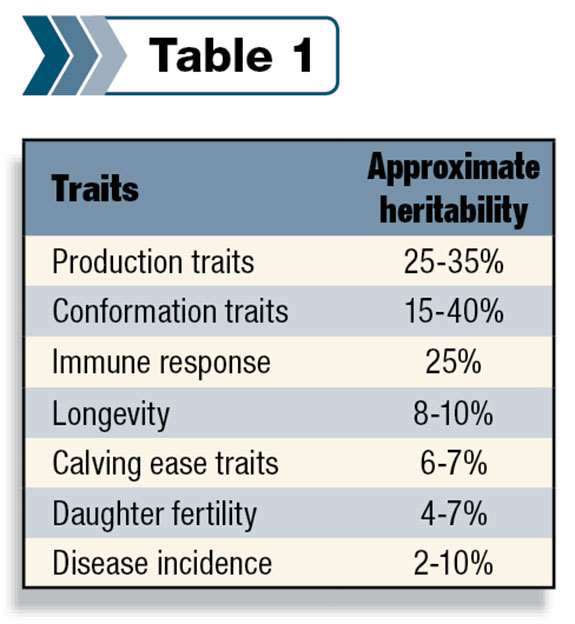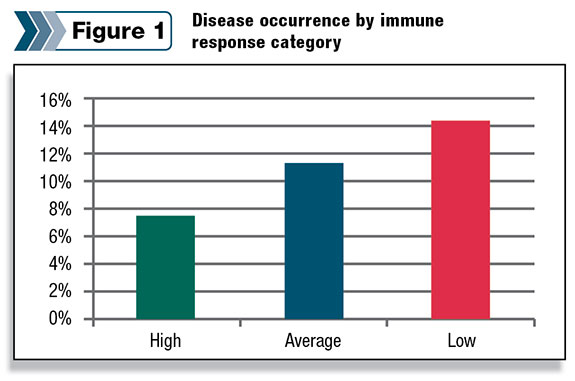Immunity is not solely explained by environmental exposure to foreign agents and other environmental factors such as diet, temperature, housing and so on; additionally, there is an important genetic component to immunity.
In fact, the immune system is under tight genetic control. Dairy producers have long recognized this fact by noticing how some cows or cow families possessed an inner strength to resist disease.
Though exposed to the same environmental pathogens, some animals were less prone to disease. This greater resilience is, in fact, a better combination of immune response genes that gives the animals a more proficient and stronger immune system to fight disease.
Immune response is controlled by many genes. The next generation of females’ immune response can be genetically enhanced by using bulls that possess more beneficial genes for this trait.
It all began back in 1980, when a keen young animal science student at the University of Guelph named Bonnie Mallard was inspired by the possibility of genetically regulating disease resistance.
She entered her masters program in animal breeding and genetics, where she studied the inheritance of immunoglobulins in dairy cattle in order to better understand the immune system’s genetic regulation and its impact on disease resistance. This led to a lifetime career in a vital new discipline called immunogenetics.
Her Ph.D. work within the Ontario Veterinary College examined a special cluster of genes known as the major histocompatibility complex and its critical role in regulating immune responsiveness in swine.
During her post-doctorate, she was the first to conduct an experiment that selectively bred for high and low immune response based on an individual’s estimated breeding values for these traits.
This research showed that immune response heritability is high enough to carry out effective selection and in this way improve animal health and response to commercial vaccines.
This research led her to a faculty position as professor of immunogenetics at the University of Guelph to work on genetic regulation of the immune system with a particular focus on dairy cattle.
Over the course of the next 22 years, while she worked closely with her colleagues at the Centre for Genetic Improvement of Livestock, the research was refined and led to the development of a set of phenotypic measurements to measure immune response and that were shown to be associated with disease resistance.
Animals with the ability to make robust and beneficial immune responses were termed high immune responders. The high immune response technology that resulted was ultimately patented by the University of Guelph.
Over the years, there have been several thousand animals tested for immune response including in research herds, commercial herds and beta test herds. Many independent studies confirm the benefits of the high immune responders.
Research has shown how high immune response cows are more resistant to a number of economically important diseases, such as mastitis.
The research program directed by Mallard has resulted in about a dozen graduate theses and close to 100 research papers in referred journals on various aspects of genetic regulation of the immune system of livestock.

One of the key research findings was the relatively high heritability of immune response. Immune response traits measured under this technology have a heritability of approximately 25 percent.
This means 25 percent of the differences between animals for immune response can be explained by the animals’ genetics.
This is close to the heritability of production and conformation traits ( Table 1 ) that have been effectively selected for.
Additionally, it is far greater than the heritability of traits such as productive life, daughter fertility or disease incidence traits.
As a result, one can expect to make significant genetic gains for immune response over successive generations, as has been achieved for production traits, while progressively reducing the incidence of health problems in our dairy cows.
The immune response test requires three visits to the farm over a 15-day period. The animals are immunized with safe and inert test antigens to measure their ability to mount immune responses to the challenge.
There are two distinct types of immune responses measured that are critical in providing a defense against a diverse group of micro-organisms found in the broad-based spectrum of viral and bacterial infections that can be present on-farm.
Once the immune response measurements have been made, they are entered in a genetic evaluation system that provides estimated breeding values for overall immune response.
The list of benefits demonstrated by this research technology is quite impressive. Research across 64 dairy herds has shown that high immune response cows have a lower incidence of disease.
In a 3,000-cow dairy in north Florida, more than 700 cows were tested. The results showed that high immune responders had 27 percent less incidence of mastitis, 17 percent less incidence of metritis and 32 percent less incidence of retained placentas compared to herd-average cows.

Across all tested herds, and by averaging the incidence of all diseases recorded, low immune response cows had twice as much disease compared to high immune response cows, and the severity of disease was also greater in the low immune responders.
Preliminary research also indicates a reduced incidence of sero-positive Johne’s cows in the group that are high for cell-mediated immune response compared to cows classified average or low.
A similar benefit is expected for a wide range of other viral and bacterial diseases since the immune system shows little preference for any one infectious disease over another.
Research has also shown that individuals ranked as high immune responders have a better response to commercial vaccines. This really shouldn’t be a surprise since the response to an introduced antigen is precisely what is measured in the immune response test.
By genetically selecting for higher immune response, dairy producers will develop animals that take better advantage of vaccination. Therefore, they can maximize the return on their investment in a herd vaccination program.
High immune response cows have also been shown to produce higher-quality colostrum with more antibodies.
So high immune response cows not only pass on their higher immune response genes to their offspring, but they also pass on early life immunity benefits through their colostrum. Herd strategies to build colostrum inventories from high immune response cows could be a future possibility.
Given the low heritability of most health traits used until now, it has been somewhat frustrating for dairy producers to try to improve animal health. And this lower heritability has limited the gains that could be achieved.
The high immune response technology can help reverse this situation. These bulls present the opportunity to breed healthy cattle that are naturally resistant to disease. PD

-
Jay Shannon
- Global Dairy Solutions Manager
- Semex
- Email Jay Shannon






